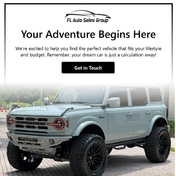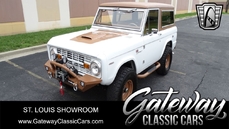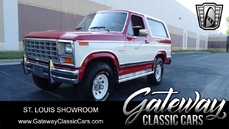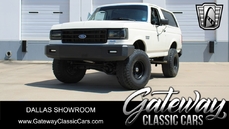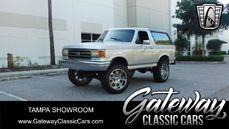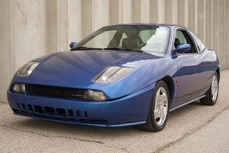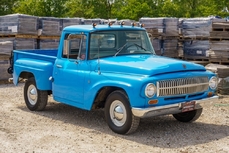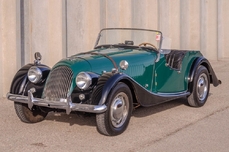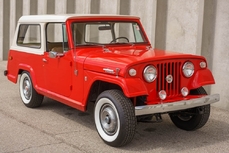Ford Bronco 351 CID V-8 1979
Allmän beskrivning :
1979 Ford Bronco Custom 4×4
Final model year for second-generation Bronco
Very desirable factory 4-speed and factory air conditioning Bronco
Four-inch lift kit
Light Medium Blue exterior (code K) with white hardtop and black interior
Cleveland 351 CID V-8 engine (VIN code H) with dual exhausts
Rare Borg-Warner T-18 four-speed manual transmission (code F) and 3.50 limited-slip differential (code H2)
35” tires and American Racing wheels
New paint and interior
104-inch wheelbase
Own this Vehicle from $389 per month-call 636-600-4600
No longer content with its multi-purpose vehicle being the runt of the Big Three, Ford upped the ante in 1978 with its Bronco model. MotoeXotica Classic Cars is pleased to present this 1979 Ford Bronco Custom 4×4 with the very desirable 4-speed transmission and air conditioning. Nineteen seventy-nine was the second-generation Bronco’s last model year.
The Bronco Custom served as the standard-trim model. Rectangular headlights became standard for all 1979 Broncos. Made in Ford’s Wayne, Michigan (VIN code L) truck factory in March 1979, this example is finished in Light Medium Blue (code K). This Bronco was delivered new to our local St. Louis, Missouri region (trim code 55).
The truck’s paint and trim are in overall very good order, with only minor imperfections noted at close range. This Bronco’s bodywork is straight, has a four-inch lift kit. The engine bay is very tidy, the battery appears new, the rear cargo area is quite tidy (and comes with a new spare tire with cover) and the truck’s chrome bumpers are in very good condition.
Under the hood is a Cleveland 351 CID V-8 (VIN code H) engine breathing via dual exhausts. For 1979, Ford added emissions controls to its light-truck engines; the Bronco gained a catalytic converter (among other equipment). Backing this engine is a Borg-Warner T-18 four-speed manual transmission (code F). Only 21.2 percent of 1979 Broncos came with a manual transmission and even more rare with factory air conditioning!
Broncos in 1979 were fitted exclusively with four-wheel drive; a part-time system was standard with a New Process 205 gear-driven transfer case with the option of permanent four-wheel drive and a New Process 203 chain-driven transfer case. Out back is a 3.50:1 limited-slip rear end (code H2). The second-generation Bronco is fitted with a coil-sprung Dana 44 front axle and has a leaf-sprung Ford nine-inch axle in the rear (similar to the later first-generation Broncos). The first- and second-generation Broncos are the only versions designed with non-independent front suspension (solid front axle).
This truck rolls on new Terra Rader light truck tires, size 35×12.50R20 at all four wheels. Each big donut wraps around a chromed and vented American Racing wheel. The wheels are in excellent condition.
Inside, a new black interior looks great! The front and rear bench seats, shot through with white and gray, look great, the black carpet and mats look excellent, A thick-rimmed, three-spoke aftermarket steering wheel faces the driver. The instrument panel, with its trim accents, features a full array of gauges and is in satisfactory order, as are the two-tone inner door panels. Completing the interior is a modern AM/FM stereo with CD player. While a two-seat interior remained standard, the 11-inch wider interior allowed for a three-passenger front bench seat; with a folding and removable rear seat, the Bronco became a six-passenger vehicle for the first time.
In place of a model-specific chassis, the Bronco was adapted directly from the Ford F-Series, becoming a shortened version of the F-100 4×4. Originally intended for a 1974 launch, the second-generation Bronco (named “Project Shorthorn” during its development) was postponed to 1978 in response to fuel economy concerns related to the 1973 fuel crisis; the second-generation Bronco was released for sale after development was nearly finalized on its 1980 successor.
While most other vehicles focused on downsizing, the second-generation Bronco added 12 inches of wheelbase, approximately 28 inches of length, 11 inches of width, and four inches of height; based on powertrain configuration, the Bronco gained 1,100 to 1,600 pounds of curb weight over its predecessor.
The second-generation Bronco marks the introduction of design commonality with the Ford F-Series and retained the lift-off hardtop bodystyle for the three-door wagon, though now fiberglass over the rear seat area only (and not a full-length steel top). Replacing the multiple body configurations of the first generation, the second-generation Bronco was offered solely as a three-door wagon with a lift-off rear hardtop. As with its chassis, the second-generation Bronco derives much of its body from the F-Series truck line, sharing the doors, front roofline and sheetmetal, and interior with the F-Series.
Retaining the wagon body from its predecessor, Ford designers shifted to a lift-off hardtop from behind the B-pillars. Designed by Dick Nesbitt, the configuration achieved higher commonality with the F-100 (sharing the doors and overhead roof stamping); attention was focused on minimizing leaks around the top seals (a problem related to the design of the K5 Blazer hardtop of the time). In a configuration similar to the Ford LTD Country Squire, the rear window glass rolled down into the tailgate (via a dash-mounted switch or from using the key on the outside), allowing the tailgate to fold down.
In spite of its short production cycle (only two years), the second-generation Bronco proved successful, overtaking the Blazer and Ramcharger in sales for the first time; initial demand was so strong that customers waited several months to receive vehicles from dealers. Ford sold more than 145,000 examples during 1978 and 1979.
Competition to this Bronco in 1979 included Chevy’s K5 Blazer, Dodge’s Ramcharger, GMC’s K5 Jimmy, Jeep’s Cherokee and Plymouth’s Trailduster.
If you seek a good-looking, classic 4×4 with a few modern tweaks, then this is the one for you. Ford and 4×4 SUV fans, you should really do yourselves a favor and visit today to check out this ’79 Bronco at MotoeXotica Classic Cars.
VIN: U15HLEH5517
This truck is currently located at our facility in St. Louis, Missouri. Current mileage on the odometer shows 26,541 miles. It is sold as is, where is, on a clean and clear, mileage exempt title. GET OUT AND DRIVE!!!
https://www.motoexotica.com/inventory/listing/1979-ford-bronco-custom-4x4/
1979 Ford Bronco 351 CID V-8 is listed såld on ClassicDigest in Fenton (St. Louis) by for Ej prissatt.
Fakta i bilen
Karosstyp : Personbil Märke : Ford Modell : Bronco Modellversion : 351 CID V-8 Motorvolym : 0.0 Årsmodell : 1979 Läge : Fenton (St. Louis)
Såld
Information om säljaren
Såld
People who viewed this Ford Bronco also viewed similar Ford listed at ClassicDigest
Other cars listed for sale by this dealer
om Ford
Ford, som grundades 1902, har utan tvekan förändrat historien om bilvärlden mer än någon annan biltillverkare genom att införa de första folkbilen Modell T 1908. De hade producerat mer än 15 miljoner bilar i slutet av produktionen 1927, genom vilket T hade blivit föråldrade.Ford lanserade den första lågpris V8-motor driven bil 1932. 1932 V8 var en omedelbar hit med överlägsen hantering och prestanda för många betydligt mer expansiva bilar av dagen. Inte undra på 32 V8 Ford har blivit en sådan favorit bland heta rodders runt om i världen med 32 Deuce Coupe som sin ikon.
Under kriget Ford helt stänga civil bilproduktionen att ägna alla sina resurser till de allierade krigsansträngningarna (1942-1945) De används för att bygga B-24 bombplan, flygmotorer, jeepar, M-4 stridsvagnar, militära lastbilar och Bren-gun bärare och mer än 30.000 super laddade Rolls Royce Merlin V-12 motorer till Mosquito och Lancaster bombplan samt P-51 Mustang fighters. Efter kriget Ford bilar i USA blev större och flashier tillsammans med sina konkurrenter. I 60: s Ford var tillbaka i förgrunden igen när man inför deras kommersiella hit Mustang 1964. Mustang var så populär tävlingen var tvungen att följa Fords exempel och ponycar fenomenet tog över USA. Under åren ponnyer växte några muskler tills oljekrisen döda äntligen dödat dem.
På sextiotalet rusade Ford i internationell motorsport scenen med en raseri. Efter misslyckade Ferrari övertagande, då Enzo Ferrari hade klippt affären av med Henry Ford II gör det senare absolut koka av vrede, vände Ford till Lola i Storbritannien för att producera en Ferrari slog långdistans racer efter. Samarbetet mellan Ford och Lola skapade den mäktiga Ford GT40 som absolut slog Ferrari i Le Mans 24 flera gånger.
I Europa införde Ford några av de mest episka race och rallybilar av 60-talet som bygger på ödmjuka familj sedaner; Cortina GT, Lotus Cortina, Escort Twin Cam, och Escort 1600RS med de ikoniska Cosworth BDA motorer.
Idag klassiska Fords är mycket populär bland entusiaster och ett stort urval av klassiska Fords finns till försäljning på www.ClassicDigest.com



